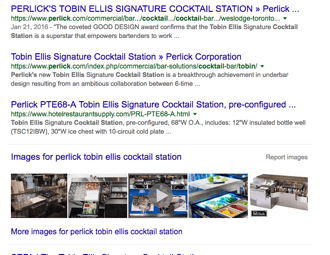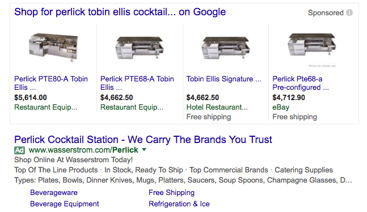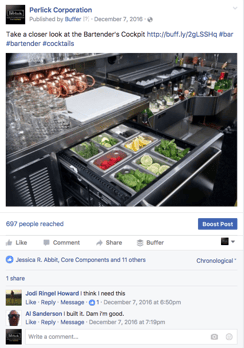Regardless of your role in a company, there are a few key digital marketing acronyms with which you should be very familiar. If you stop and think about it, your buyers in the foodservice industry are engaging with you online like never before. Understanding terms like Search Engine Optimization, Search Engine Marketing, and Social Media Marketing will only help your company continue to grow. So what's the difference between SEO, SEM, and SMM? Let's take a look at all three.
SEO - Search Engine Optimization
 Search Engine Optimization (SEO) is a set of ongoing best practices used for your website and blog to help you get found online via the top search engines like Google, Bing, and Yahoo. These techniques help improve a website's SERP, or Search Engine Result Page. There are two types of SEO: on-page and off-page. On-page includes using keywords correctly throughout your web pages, including title tags, H1 through H4 tags, URL structure, alt tags on images, among a host of other practices. Think of the Google 'snippet' when you search for something either by typing in the long-tail keyword or speaking it directly to Google or Siri. Good on-page SEO practices will help ensure your company and products/solutions get found by the right people.
Search Engine Optimization (SEO) is a set of ongoing best practices used for your website and blog to help you get found online via the top search engines like Google, Bing, and Yahoo. These techniques help improve a website's SERP, or Search Engine Result Page. There are two types of SEO: on-page and off-page. On-page includes using keywords correctly throughout your web pages, including title tags, H1 through H4 tags, URL structure, alt tags on images, among a host of other practices. Think of the Google 'snippet' when you search for something either by typing in the long-tail keyword or speaking it directly to Google or Siri. Good on-page SEO practices will help ensure your company and products/solutions get found by the right people.
Other key on-page SEO techniques include:
- Friendly navigation
- Fast loading pages
- Mobile friendly pages
- High quality on-going content (the most important piece of SEO)
Off-page SEO is just that: best practices that are external to your website and blog. These include back-links (other relevant companies with good Google credibility linking back to your web-pages). Think of these as 'votes' received for your content being so remarkable. This 'voting' happens when another website links your content in their own blog, using it as a source, giving your content further credibility. Naturally off-page SEO is much harder to achieve because you are relying upon outside sources. One great example of off-page SEO is when a manufacturer rep posts a blog on their website about your factory and brand(s), and you then reference that article in your own blog. And visa v, right? Factories and reps should be working hand-in-hand along with dealers, consultants, and even end-users to share content that is all in their own best interest. This is how you can really 'win' on the web.
Another key aspect of off-page SEO is Social Media Marketing. We will address that in a bit.
SEM - Search Engine Marketing
 Search engine marketing is the process of driving traffic to your website using paid online advertising. In other words, you pay Google for Google AdWords, ideally your content comes up first driving more awareness and traffic. You may have heard of Pay Per Click or PPC. Today, the cost of AdWords and paid campaigns has gone up significantly with the search engines due to saturation of the market, thus leading to the next phase of SEM, paid advertising on social media platforms. See a trend here?
Search engine marketing is the process of driving traffic to your website using paid online advertising. In other words, you pay Google for Google AdWords, ideally your content comes up first driving more awareness and traffic. You may have heard of Pay Per Click or PPC. Today, the cost of AdWords and paid campaigns has gone up significantly with the search engines due to saturation of the market, thus leading to the next phase of SEM, paid advertising on social media platforms. See a trend here?
SMM - Social Media Marketing
 Inherently, social media marketing (SMM) is part of on-page SEO because of link building. Have you Googled your name lately? Take a look at the first few results. Do you see a link to your LinkedIn profile? Twitter? This applies to businesses, as well. Being on these social platforms helps your company, and your brand(s), get found easier.
Inherently, social media marketing (SMM) is part of on-page SEO because of link building. Have you Googled your name lately? Take a look at the first few results. Do you see a link to your LinkedIn profile? Twitter? This applies to businesses, as well. Being on these social platforms helps your company, and your brand(s), get found easier.
The goal of SMM is to drive quality traffic to your website, landing pages, and blogs, to get them to engage with you, and ultimately, drive revenue with a trackable ROI. Facebook. Twitter. LinkedIn. YouTube. Google+. Instagram. And now Snapchat.
The key to engagement is: 1) identifying which platform your buyers are actually on, and 2) fully understanding your buyers (or followers) and providing them personalized remarkable content. For example, if you are bar and beverage manufacturer targeting bartenders, your content strategy should help bartenders. This information will help you to better educate customers, make you a thought leader in the industry, and keep your brand at top-of-mind awareness. At the end of the day, you are creating your cultural voice online with social media marketing.
An SMM strategy can also include paid advertising across social platforms.
[Related: How Today's Sales Rep Uses Social Media]
Ready to maximize your foodservice business' marketing and sales strategy? Download our Inbound Marketing Cookbook, and learn how to transform the way you go to market.
